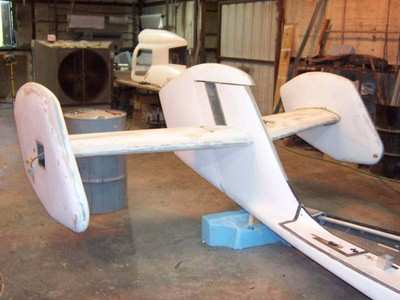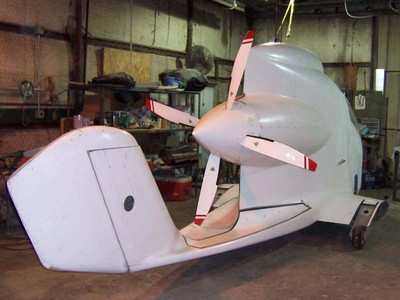Jay Carter Hints At Dramatic Demo Flight Ahead
by ANN Senior E-Media Producer Paul Plack
There's an old saying which holds, "you can tell a lot about a
man by the company he keeps." If that wisdom can be extended to
businesses, Carter Aviation Technologies is in great company as it
pursues development of its next-generation Personal Air Vehicle
(PAV) prototype.

At a Thursday morning press conference at AirVenture, company
President Jay Carter, Jr. and newly-named VP of Business
Development and Marketing Anita Infante discussed the contributions
of an impressive list of partners to the development of
Carter’s revolutionary, Slowed Rotor/Compound (SR/C) Aircraft
technology.
One major departure from the original CarterCopter is
replacement of the small-block Chevrolet V8 powerplant, which the
company says politely, "proved difficult to integrate for flight
use." Instead, the new PAV will start with a Lycoming IO 540 for
initial flight testing, allowing estimated speeds of 180 MPH at
7,500 feet. A later upgrade is planned to the 350 HP, twin
turbo-charged TIO 540 engine, estimated to allow 210 mph at full
power at 7,500 ft, 223 mph at 12,500 ft or 242 mph at 20,000
ft.

Ultrimately, Carter intends to use Lycoming's just-introduced,
multi-fuel, IE2 version of the engine to allow the automation and
versatility that Carter has envisioned for the PAV.
To control the aircraft, Carter is turning to Blue Mountain
Avionics (BMA), a Tennessee company which has developed a
reputation for putting cutting-edge avionics and autoilot
capabilities in the hands of homebuilders. The Blue Mountain
EFIS/Two panels will provide navigation and guidance, and the Blue
Mountain autopilot is being extended to control the PAV as easily
as any aircraft.
BMA President Greg Richter observed, "flying a rotorcraft may be
harder than flying an airplane, but flying both at the same time is
a real challenge. Carter’s PAV requires advanced electronics
to make it easy to fly and simple to operate, and the controllers
I've designed operate the Tilting Mast, Landing Gear, Prop, Data
Collection, video and RADAR altimetry and are all visible via a
high-power Ethernet air to ground data network.”

The original Carter prototype had a pressurized cabin. The
initial PAV prototype will not be pressurized, so Sky Ox Oxygen
Systems will be used for high altitude flight-testing and long
range cruise. As the prototype progresses, Ice Management Systems
will integrate a de-icing system for the aircraft. Concorde Battery
and AeroShell are providing product support.
Jay Carter, Jr. expressed excitement at seeing progress on the
prototype. “Our first prototype was built exclusively for our
own research and development purposes – to prove our
technology. Now we are looking at the refinements of the technology
and how we can best impact the marketplace. The help of these new
partnerships is invaluable. They are enabling us to use advanced
technology that they have created to improve our capability and
reliability. Together we will have defined a revolutionary new
aircraft.”
The PAV concept builds on experience with the earlier
CarterCopter, a two-seat technology test bed which functioned as a
jump-gyroplane for takeoff and low-speed flight, then gradually
transitioned to flight as an airplane at higher speeds, using small
wings to unload the rotor. Using proprietary technolgy to allow
slowing of the rotor in high speed flight for reduced drag, the
original CarterCopter achieved speeds of 170 MPH in forward flight,
and could then reload the rotor for landing as a gyroplane, using
inertia stored in tip-weighted rotorblades, and Carter's patented
smart landing gear.

The new PAV will be a four-seater capable of vertical takeoff
and landing, and forward speeds as high as 242 MPH at 20,000 feet.
The craft will benefit not only from Carter's proven rotor,
technology and landing gear technology, but also from a new tilting
rotor mast which can adjust its angle to accommodate varying CG,
hold the high-speed wings at their optimum angle-of-attack under
all flight conditions, and even allow a landing flare without
requiring the fuselage to depart from its level attitude. Carter
says the PAV's new main gear can absorb straight-down autorotative
landings at descent rates of 20 - 24 feet per second, depending on
load, and can be sacrificed in an emergency landing at up to 36
feet per second.
First flight of the PAV prototype is slated for December,
barring any major problems, and expected to take place in Texas.
The news conference at AirVenture was sprinkled with hints which,
together, suggest Carter is planning a demonstration flight
covering 5,000 miles in 24 hours, unrefueled, starting with a
vertical takeoff. Stay tuned!
 Aero-News: Quote of the Day (04.28.25)
Aero-News: Quote of the Day (04.28.25) ANN's Daily Aero-Term (04.28.25): Decision Altitude (DA)
ANN's Daily Aero-Term (04.28.25): Decision Altitude (DA) ANN's Daily Aero-Linx (04.28.25)
ANN's Daily Aero-Linx (04.28.25) Airborne-Flight Training 04.24.25: GA Refocused, Seminole/Epic, WestJet v TFWP
Airborne-Flight Training 04.24.25: GA Refocused, Seminole/Epic, WestJet v TFWP Aero-News: Quote of the Day (04.29.25)
Aero-News: Quote of the Day (04.29.25)





